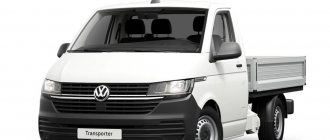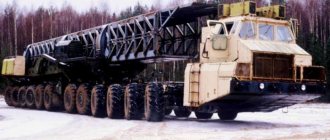Specialized trucks Classification of cargo trucks
| Trucks: types, dimensions, load capacity | Road transport of goods Despite the constant development of global volumes of sea, air and rail transport, land road transport by trucks of 10, 20 tons or more remains in demand. In cases of operation of dump trucks with an efficiency factor significantly higher than 0.5, it is allowed to normalize fuel consumption in the same way as for on-board vehicles. |
- eurotruck - a tented semi-trailer capable of holding up to 33 euro pallets with cargo;
- Jambo is a modified version of the Euro truck with the same carrying capacity, but the internal volume is increased due to the L-shaped floor and the reduced diameter of the rear wheels;
- automatic coupler, road train - a car with a tented body on one frame, to which a trailer is attached using a drawbar; the coupling is ensured by the presence of a towbar.
Table of the main characteristics of the trucks • Size, length, width, dimensions and carrying capacity of the truck; the choice of the listed parameters depends on the type of items being delivered.
Weight characteristics of trucks
Heavy-duty vehicles of the “European truck” are a popular type of freight transport in the Russian Federation and former CIS countries, and the option with a tent covering is considered especially convenient: you can remove it and load/unload from three sides simultaneously.
A standard European-type vehicle holds 33 pallets, weighs 22 tons, while a truck with a trailer weighs from 14 tons, depending on the modification.
See how the Scania Eurotruck is unloaded:
Important! The weight of the tractor varies depending on the brand, ranging from 7 to 8.5 tons, so a loaded truck weighs from 36 to 38 tons. The coupling of a tractor with a semi-trailer can be in both loaded and “free” states.
Eurotent
For this option, the dimensions and weight characteristics are within the following limits:
- linear size – 13.6 m;
- height/width – 2.45 m;
- useful area of the semi-trailer – 33 m2:
- internal space – 82 m3;
- the average weight of a truck with a trailer without cargo is 14.5 tons;
- permitted tonnage – 20–22 tons.
Curtainsider semi-trailer
A semi-trailer with an awning differs from other options in that it is possible to install additional equipment that expands the scope of application. In some cases, it is recommended to use a trailer with a side height of 35–50 cm along the perimeter as an open platform for transporting large cargo.
Refrigerator and isotherm
Such specialized machines are used when transporting food or goods that need to be stored at certain temperatures.
Modifications of refrigerators:
- volume from 75 to 79 cubic meters - length varies between 12.6–13.0 m;
- large volumes correspond to an increase in dimensions up to 13.6/2.5/2.7 m (l/w/h).
The weight of the truck without cargo is from 14 tons. The suspension is made of two types: spring and air cushion, which is used when transporting glass containers. A special freon refrigerator constantly maintains the optimal temperature inside the van.
Refrigerated truck classification table:
| №/№ | Installation class | Temperature, °C |
| 1 | A | from +12 to 0 |
| 2 | B | from +12 to -10 |
| 3 | C | from +12 to -20 |
| 4 | D | ≤+2 |
| 5 | E | ≤-10 |
| 6 | F | ≤-20 |
Refrigerated trucks allow you to transport deep-frozen or chilled products, flowers, cosmetics and much more over long distances, regardless of weather conditions.
Refrigerated semi-trailer
The insulated design of a large capacity semi-trailer is practically no different from smaller vans. dimensions are :
- length – 13.6 m;
- width – 2.45 m;
- height – 2.45 m;
- volume up to 82 cubic meters m;
- payload – 22–25 tons.
How much does an empty truck weigh? The figures for this parameter will be as follows: tractor from 7 + 6.1 = 13.1 tons, and a loaded vehicle - 35.1–38.1 tons .
The cargo compartment of the Thermovan class is capable of maintaining the temperature at which loading was carried out for 10–20 hours. For example, in the range from -10 to +20 °C.
Isothermal semi-trailer
Special models are produced where it is possible to heat the internal volume of the cargo compartment, which is important at external sub-zero temperatures. The sides of the van are lined with thick foam and tin, the rear doors are lined with insulation, and there are ventilation perforations or slots. There is an additional door on the side, which makes loading easier.
Platforms
These types of freight transport are used to move non-standard structures that are resistant to weather conditions, for example: reinforced concrete blocks, containers, steel beams and trusses.
Container ship
This car has standard parameters. For example, linear ones are up to 12.5 meters, and overall ones are 2.5 × 2.5 m. Maximum loading is 25 tons. Open platforms are used to move two 6 m containers or one 12 meter container. In international terms this would be 20 and 40 feet respectively.
Container transport platform
Low bed platform
This design is called a trawl, the dimensions are impressive: length from 11 to 20 m, and width - 2.5-3.7 m, designed for transporting large loads - up to 93 tons . The number of axles varies from 1 to 8, which increases the platform's load capacity. The sliding semi-trailer has a telescopic boom-type frame design, side extensions also increase the width of the floor if necessary.
Low bed platform
Lengths
The dimensions of the internal part of the semi-trailer are 13.6 × 2.45 m, the side height is from 50 to 80 cm, the loading is 20–24 tons . Scows are used to reliably move large structures. To transport pipes, bunks are installed.
Semi-trailer for large cargo
Tanks
This type of truck is used for the delivery of technical liquids and food products. These can be milk tankers or alcohol tankers. Oil, gasoline or kerosene, which are chemically aggressive, are also poured.
The internal volume differs in configuration - containers are used, separated by strong bulkheads into several compartments. Tonnage – no more than 20 tons , volume varies from 20 to 40 m3.
Tank semi-trailer
Dump trucks
This is the name given to self-unloading flatbed vehicles equipped with a separate body or an additional trailer, which are used for transporting bulk cargo. The difference is that the body is released independently and quickly by tilting back or to the side. The maximum load directly depends on the class of the car.
A dump truck has another name - a heavy semi-trailer.
Dump truck at work
Timber trucks
The vehicles are equipped with a specially designed semi-trailer that allows transportation of long timber, lumber, and pipes. To securely secure the load, special devices called bunks are used. The maximum weight of transported cargo on timber trucks is up to 30 tons.
Loading a timber truck
Grain trucks
They are distinguished by a body of increased volume due to the use of a specially designed tank or bulk bunker, which is adapted for transporting grain or granulated feed. Such vehicles are equipped with a self-unloading system or folding sides.
Load capacity varies between 15–24 tons , capacity up to 60 cubic meters. m.
Grain truck on the field
Car transporters
Special vehicles for transporting passenger cars or light trucks and other wheeled vehicles. The design consists of a two-level platform type that accommodates 7–10 B-class vehicles.
The car transporter semi-trailer has a linear dimension recommended by regulatory documents - 20 m, and a load capacity of up to 20 tons .
Loaded car transporter on the way
Road train
Consists of a tractor and several trailers. Tactical and technical data of the road train options are given below.
Volume 110 cubic meters:
- length inside: van – 7.7 m, trailer – 30 cm more;
- height: van – 2.95 m, trailer – 5 cm higher;
- payload – up to 25 tons.
“Mega” –120 m3:
- linear dimensions of the body and trailer – 8 m each;
- height – 295 cm;
- standard width – 245 cm.
Road train with tilt semi-trailers
"Jumbo"
This is a modification of the “European truck” with a similar maximum load; the useful volume is increased due to the floor in the shape of the Russian letter G and the smaller diameter of the semi-trailer wheels.
Length inside the body: the first section of the floor is 4.2 m, the second is 9.6 m, and in total – 13.8 m with a width of 2.45 m. The ceiling is located at a distance from the floor – 2.45 and 3.0 m .
You can see what a jumbo semi-trailer looks like here:
Tilt eurotruck 20 tons
However, cargo carriers themselves are not averse to “improving their business model.” For example, Pavel Chemodanov has a cherished dream - to build a warehouse. “If you have at least a small warehouse, you can already collect consolidated cargo, when small consignments of goods from different customers go in the same direction,” shares Pavel, “plus responsible storage! And these are completely different turns.” However, even the construction of a warehouse with an area of only 2 thousand square meters. m will cost Pavel at least 2000 million. You can’t earn that kind of money in cargo transportation.
How much does a truck eat per 100 km, loaded and unloaded?
We determine the volume of transport work W = Ggr x Sgr = 20 tons x 300 km = 6000 tkm.
3. Diesel fuel consumption will be: 0.01 x (31.1 x 610 + 1.3 x 6000) x (1 + 0.01 x ((15% city x 70\610 + (-15% suburban area x 420\ 610 + 10% age)) =
= 0.01 x (18971 + 7800) x (1 + 0.01 x ((1.72 + (- 10.32) + 10)) = 0.01 x 26771 x (1 + 0.01 x 1, 4) =
A complete list of onboard trucks of domestic production and CIS countries with basic fuel consumption standards is in section 9.1. methodological recommendations “Consumption standards for fuels and lubricants in road transport” No. AM-23-r dated March 14, 2008.
The list of foreign cargo flatbed vehicles with basic fuel consumption standards is in section 9.2. the same methodological recommendations.
Tipper trucks
For cargo flatbed vehicles and road trains performing work counted in ton-kilometers, in addition to the basic norm, the fuel consumption rate increases at the rate of liters for each ton of cargo per 100 km, depending on the type of fuel used for gasoline up to 2 liters; diesel fuel up to 1.3 l; liquefied petroleum gas CIS up to 2.64 l; compressed natural gas LNG up to 2 cubic meters. Thanks to the special design of the tractor, it is able to reach high speeds on straight sections of the road and can easily take turns even when the trailer is fully loaded.
How many tons of cargo can be transported by truck? © Mega hitch 120 cubic m
| Calculation of fuel consumption according to standards for ref 2.0 | tor cases A classic example of the use of this technique is the famous five-line Ono no Komachi hana no iro wa Here are the colors of the flowers utsuri ni keri on They faded while in this world itazura ni I lived carelessly, waga mie ni furu Contemplating the lingering rains nagameseshimani. A long row of carriages, armed guards, an equestrian retinue of Hungarian nobles, carriages upholstered in fabrics, carts of clergy, carts and wagons carrying the rich dowry of the princess, decorated with gold and silver, clothes and linen embroidered with precious stones and thread, scarlet pillows, carpets, dishes , brocade, gold and crystal, fragile Venetian glass and priceless mirrors. |
| Carrying capacity of a truck - maximum permissible loads As Valery Voitko recalls, many southern carriers who relied on the Novorossiysk port ended up with refrigerators when cargo flows changed, they were left out of work, and in order to somehow recoup the invested funds, they began to transport everything in expensive trailers up to scrap metal. The STT LOGISTIC company has been engaged in cargo transportation of varying complexity in Moscow, the Moscow region and other regions of the Russian Federation for quite a long time. |
Jumbo truck 96 cu. m. (JUMBO) • maybe there will still be a passing cargo that will gobble up 70 thousand worth of diesel fuel.
How much does a truck eat per 100 km, loaded and unloaded?
“The first thing an entrepreneur should think about when entering the transportation business is to decide what he will transport,” advises Voitko. “The choice of trailer depends on this: you can buy an awning, a car transporter, an isothermal van (without a refrigerator), a refrigerator (already with a refrigerator ), container ship.
Russian carriers now have three main problems: personnel (there is a catastrophic shortage of professional drivers - the old training system has been destroyed), the price of diesel fuel, which has risen in price by 27% over the year, and forwarders (dispatchers). Although it is the dispatchers who provide work for the majority of truckers, they hate them, calling them bloodsuckers. It should be noted that they have every reason for this.
“We can only receive an order through an intermediary,” Olga complains, “and often there are five of these intermediaries!” Everyone snatches his own, as a result, the markup can reach 10-50% of the order price. The carriers may get less money than the lady sitting on the home telephone. Many enterprises order transport services through their intermediaries, where management employs uncles and aunts, and almost everything is based on kickbacks. We have people from St. Petersburg in Bryansk, entrusting orders to their own. When the gas pipeline near Astrakhan was dismantled, the pipes were transported to Timoshevsk, the cost of the flight was 170 thousand rubles, the carrier received 30 thousand, the rest went to intermediaries.
It is almost impossible to find an order on this market on your own if you do not have regular partners. As Valery Voitko assures, “we do not have a forwarding market, but simply the resale of cargo information.” The most popular online ordering exchange is ati.su, where up to 25 thousand offers appear daily, almost all of them from intermediaries (there is also a section about unreliable partners).
“We are no different from the apartment rental market,” Olga continues, “and we are scammed and cheated in the same way.” In the same Bryansk, one forwarding company last year “threw away” 80 carriers at once.
— The scheme works clearly: a forwarding company is created, advertises, collects money from customers, hires carriers, but does not pay the money. And after a couple of months he disappears with the money,” assures Igor Pinchuk. “I know those who were scammed out of 10-20 million rubles.” It’s not difficult, one hundred downloads in Krasnoyarsk - already 15 million.
Drivers are also happy to scam their employers. Sometimes company owners, according to Voitko, turn a blind eye to such trifles - there is no one to hire.
“It’s such a game: it’s nice for the driver to deceive the owner, and for the owner it’s a small loss,” Voitko laughs. “A friend of mine had a case: the driver called him and said: “The cops slammed at the checkpoint, they’re asking for two thousand,” and he sees on a computer (now many people install location monitoring systems using GPS navigation, from 17 thousand rubles) - it is being unloaded. He joins the game and says: “Agree for 700 rubles, I’ll pay.”
It happens that the driver either drank the money or lost money. True, some are playing out: several Pinchuk drivers received from two to five years probation for theft of diesel fuel on an especially large scale. Pinchuk says that on long-haul flights 100 thousand rubles can be lost. fuel.
The driver must have several documents with him: passport, license, insurance, cargo invoice, waybill, power of attorney for the truck (if it is not personal property), contract with the company. If something is missing, there will be problems at every traffic police post (it is trucks that bring the main income to stationary posts). Here, even regular radio exchange on a “long-range” wave does not help.
— They stop me for not having a waybill, I give the traffic cop a hundred, and he: “Look at the kind of cigarettes I smoke and how much are you offering?” - says Anatoly. - The roads to the south of the country are narrow, and if a KamAZ truck loaded with watermelons is going 30 km/h ahead, you get out into the oncoming traffic, and this is either deprivation of your license or money: the traffic cops understand that I can’t live without a license, and They may ask for 15 thousand. Or in the spring they put up signs - the limit is 3.5 tons (or 7 tons), you can’t even drive empty: truckers have always been an excellent feeding ground for traffic cops.
basic information
A driver faced with the impossibility of continuing his journey with a loaded truck may fall into panic. After all, such a car cannot be transported using a cable, like a passenger car, since it will not be able to move. In this situation, a tow truck in Moscow will help you. To call it, you need to contact our company.
There are three groups of situations in which evacuation may be necessary: at the request of the driver, planned and forced. The first group includes the following cases:
- Sudden engine failure or other defects that make further movement of the vehicle impossible.
- A traffic accident resulting in damage to the vehicle.
- The need to evacuate to the repair site.
- Lack of fuel.
- A natural situation associated with weather changes.
If we talk about planned evacuation, it is usually used when it is necessary to transport a truck from the territory of a vehicle park to a service station. There are also cases in which evacuation is forced:
- Violations of standards for the transportation of dangerous goods.
- Stopping a truck in an unauthorized place.
- Serious defects in the vehicle.
- Violation of the overall dimensions of the vehicle due to the cargo being transported and its inability to fit into the body.
- Overweight of the truck.
- The driver does not have a document confirming his right to drive a truck.
- The driver is under the influence of alcohol or drugs.
- Lack of necessary documentation for the cargo located in the back of the truck.
The evacuation of such vehicles must be carried out using powerful, durable and fast-moving equipment. For this purpose the following can be used:
- Tow trucks that perform semi-loading. They pull the truck onto the platform using special cables and fasteners, leaving its rear wheels on the road, and thus transporting it to the desired location.
- Power double winch truck tractors. They place the loaded truck on the platform using guides. This method of transporting it is considered the safest.
- Tow trucks. They are usually used when there is a malfunction in the chassis system of a freight transport, and they operate on the principle of a rigid coupling.
- Loaders with a special platform and a crane.
The cost of the described service will depend on a number of important factors.
These should include the location of the loaded truck, its parameters, as well as the need for any additional services. It should be noted that in some cases, the truck is manually unloaded before evacuation. Our company is ready to provide you with assistance in providing the described service around the clock. 02/19/2019All articles
Eurotruck 90 cubic meters m. (EURO)
However, it is also the most dangerous; in winter, just drive along some federal or local highway to see how many trucks lie in ditches due to the fact that drivers do not adhere to sleep and rest schedules, and also often overload their vehicles. vehicles. For cargo flatbed vehicles and road trains performing work counted in ton-kilometers, in addition to the basic norm, the fuel consumption rate increases at the rate of liters for each ton of cargo per 100 km, depending on the type of fuel used for gasoline up to 2 liters; diesel fuel up to 1.3 l; liquefied petroleum gas CIS up to 2.64 l; compressed natural gas LNG up to 2 cubic meters.
Ticket for a truck: why piggyback transportation is more profitable than regular long-distance transport
For once, our shippers, carriers and consignees realized that buying a train ticket for a loaded truck is much more profitable than driving it across the country.
Valentin Ozhgo
A tractor with a semi-trailer does not need “nesting in a basket” - it goes to the platform and back on its own.
Finally, the talk about piggyback transportation turned on the red signal: carriers began to move from words to action. However, in the old days, they also took on things quickly, but never brought the work they started to its logical conclusion. In 2020, the topic of piggyback transportation was developed again. However, Avtopark, which scrupulously monitors all new products in the segment of road freight transportation and logistics, is of the opinion that the starting year is not this year, but last year. It was then that a special open platform for transporting mainline tractors and semi-trailers was noticed on the experimental railway ring of JSC VNIIZhT in Shcherbinka.
Considering that nothing happens for nothing in Russian business, the appearance of specialized rolling stock for piggyback transportation was caused by someone’s interest. And not alone. The special four-axle platform model 13‑5205 was manufactured by Uralvagonzavod. This year it went into mass production and shipments to customers began. The design with a low level of the plank floor allows you to fit into the overall dimensions and freely drive cars from the end of the platform or from the front.
A Scania R440 tractor with a loaded Kassbohrer curtain semi-trailer in the process of anchoring using wheel chocks.
True, there has not yet been a rush of demand for piggyback transportation. On the eve of summer, another test of the platform car 13‑5205 was carried out using a removable loading basket. If in October the First Expedition Company tested a platform with a long-haul tractor and a semi-trailer, then this May ITECO Russia sent only a semi-trailer on the road. It is better to consider the advantages and disadvantages of the two methods using examples. Let’s say right away that both delivery schemes are convenient and effective, but not everywhere and not always. In Europe, where any country can be crossed in a day or a few hours, a mainline tractor with a semi-trailer on a railway platform is effective. In Russia, where piggyback transportation takes a thousand or more kilometers, this technology is unprofitable.
This year, shipments of the serial universal piggyback platform UVZ 13‑5205 began.
That’s why our carriers are in no hurry to adopt European experience. For example, a test shipment from Moscow to Novosibirsk in October 2019 from the Orekhovo-Zuevo station near Moscow to the destination, as Magomed Gasanov, head of the transport logistics service of the First Expedition Company (PEK), shared his observations with Avtopark, took six days. The eurotruck, consisting of a semi-trailer with a tractor, was sent on a platform to study the possibility of delivering goods not only to the final point of the railway route, but also to those cities located within a radius of 700 km from the unloading station.
As part of the optimization of the transportation process, the topic of piggyback transportation has begun to be heard more often, and this is already encouraging, but the project is still far from being implemented. The problem remains: until the tariff schedule has been formed and infrastructure issues have not been resolved, Russian carriers have no idea about the commercial prospects for using piggyback service. We are not in Europe, the conditions are different.
The carrier’s task is to deliver the semi-trailer to the station on time, then the railway workers take over.
We are talking not so much about weak infrastructure and the cost of the service, but about the main tractor, which is a tool for making money. According to the laws of business, any tool should not be idle, it must work. And for a week, a mainline tractor traveling on a platform somewhere to Krasnoyarsk or Novosibirsk, for the passage of which you also need to spend money on a ticket, is practically idle. Along with the “tadpole”, the driver is also idle, who needs to pay travel allowances in addition to his salary.
A container reach stacker with flexible spreader suspension belts has also become a piggyback crane - there is enough power potential.
Therefore, in Russian conditions, transportation of a loaded semi-trailer without a tractor using a removable loading basket seems to be a more flexible and promising model of piggyback transportation.
GET ON THE PLATFORM!
A loading basket is a mandatory attribute for a semi-trailer, since only 0.5% of the Russian vehicle fleet has a reinforced body structure and special places for lower hooks to grip loading equipment. A semi-trailer with a length of up to 17.4 m and a gross weight of up to 36 tons, together with the basket, is moved onto a platform car and secured. Upon arrival of the train at the place, the basket with the semi-trailer is unloaded and the vehicle is given to the recipient, who arrived at the station with his tractor.
PEC plans to launch regular piggyback transportation in September. Loading will be carried out in the Lobnya area at the terminal and warehouse complex. The final destination will be Kleshikha station in the Leninsky district of Novosibirsk. It is planned to launch 20 trains with 50 platforms on this route. If it is possible to reduce the time for consolidating and issuing semi-trailers at the receiving station, then it can be done in five days, which is significantly less than road delivery.
The driver of the tractor can only carefully pull the semi-trailer into the basket and precisely position it above the wheel wells.
An equally venerable international operator on the Russian logistics market, DB Schenker, together with the First Federal Piggyback Operator (PFKO), which owns the platform with the basket, also made a test piggyback flight in the spring. And also without a tractor - only a semi-trailer. It was not by chance that the test trip went south along the route St. Petersburg - Sochi: the difficult terrain has restrictions for the movement of heavy vehicles. That direction partially repeats the piggyback pattern in the alpine part of Switzerland, only longer.
Previously, platforms of previous generations were not allowed to carry trucks due to exceeding the permissible height dimensions - tunnels in the Caucasus Mountains have standard sizes. Due to the downward displacement of the load, the platform developed by PFKO successfully passed all the tunnels with the semi-trailer, fitting into the specified dimensions. This pleased DB Schenker most of all, which has extensive experience in organizing piggyback transport on the European market.
Under the lower edge of the platform, scissor-type wheel cells are clearly visible, thanks to which the semi-trailer moves down.
It must be said right away that not all drivers are delighted with piggyback transportation. And here we can agree on many things with ordinary participants in the transportation process, who are well versed in the topic not from the position of the office, but the realities of the road. There are a lot of inconveniences for the person driving, including, due to the problems with such a traffic pattern, making a ferry/train break in accordance with very regulated narrow standards. This has to be taken into account, since the countdown starts from the moment the current work shift opens, and travel in a carriage cannot always be considered as rest in the concept of the driver’s work and rest regime.
PUNCTUALITY - POLITENESS OF TRAINS
Kaliningrad, which is a transport and logistics outpost of Russia on the western borders, is also preparing to send piggyback trains. In addition to the transshipment of containers from Europe to China and back, the topic of transporting loaded semi-trailers through the Russian Railways network is being actively explored. The technology was first tested on the route from Kaliningrad to St. Petersburg: a semi-trailer with local polymer products very quickly arrived in the Northern capital.
In May, the first shipment to Moscow was organized. The travel time of a loaded semi-trailer from the departure station to the destination station is less than two days. This is two times faster than the road delivery scheme at a comparable cost of transportation costs. Shippers and recipients themselves note a reduction in logistics costs due to faster passage of international checkpoints by rail.
It is expected that with the new technology, not only the volume of rail transport will increase, but also road traffic will be relieved. Road workers are also rubbing their hands: the aggressive impact of heavy trucks on the asphalt surface is being reduced.
In the near future, to serve Moscow traffic on a regular basis, the operator plans to purchase 50 piggyback platforms, which will go not only to the capital, but also, if there are orders, to anywhere in the country. Marketing research shows that such orders will...
To ensure uninterrupted operation in this segment of transportation, the Kaliningrad Railway has modernized its fleet of loading equipment. Among the most significant purchases is a gantry crane labeled “Baltkran”. This is a landmark delivery for the manufacturer - the 200th crane.
An update for operations with containers, pneumatic tires on main vehicles and special equipment appeared as part of the “New Silk Road” project. The carrying capacity of the “celebrator” is 45 tons, the length of the bridge is about 50 m, including consoles. In addition to reloading containers of different size groups, the crane successfully loads loaded semi-trailers using a spreader and lower gripper. It is equipped with a modern remote monitoring system, metering equipment, and an innovative anti-sway system, ensuring smooth operation even in strong winds.
Magomed Gasanov, head of the transport logistics service of the First Expedition Company (PEC)
More promising are piggyback transportation of semi-trailers only. This is economically beneficial, since the semi-trailer will become an independent vehicle. At maximum speed, we can only purchase semi-trailers that are cheaper than truck tractors. However, to scale this transportation scheme, it is necessary to create a regulatory framework that will regulate the legal aspects of the interaction of all parties to the transportation process. In addition, it is necessary to modernize at least the main infrastructure so that railway rolling stock, container terminals and stations can serve either trailers or trailers with tractors. We need access roads and special equipment - reach stackers, which are currently only available at Plyushchikha and Bely Rast stations. In addition, the development of the service is limited by the tariff. It must be commercially attractive and at the same time include the costs of the carrier, JSC Russian Railways as the owner of the network and locomotive facilities, as well as rolling stock operators.
Aivars Tauriņš, General Director of DB Schenker Russia/Eurasia cluster
Our European offices carry out more than 10 thousand shipments per year on the Verona - Rostock route alone. The use of a piggyback scheme allows for continuous transportation of cargo 24/7. A driver is required only for the “first and last mile,” which solves the problem of personnel shortages in the road transportation market. The piggyback scheme is in demand in difficult climatic conditions. For example, during heavy snowfalls, when roads become impassable, the railway transports goods without hindrance. Besides everything, this is one of the most environmentally friendly types of transportation. Based on the experience of European offices, we see that the use of rail platforms on some piggyback routes with particularly intense freight traffic minimizes carbon dioxide emissions into the atmosphere by up to 83%. At the same time, the costs of piggyback transportation are comparable to conventional road transportation.
Andrey Gnibidenko, driver of the Polish company KOIMEX SA
As a driver, transporting a truck by train gives me a lot of inconvenience. Firstly, it costs time, since driving some areas is much faster. But Austria differs significantly from many countries in its struggle for the environment and restrictions on trucks. Both weight and speed. For example, at night from 22:00 to 5:00, traffic in Austria is allowed, but only for trucks of the sixth environmental class and with a maximum speed of 60 km/h. Secondly, food in the carriage is paid for for drivers. Thirdly, problems with the tachograph and the ferry/train pause mode. If you compare it with a ferry, the driver receives free food and a cabin with a shower room. Let's take as an example the specific section of Vergl - Brenero. The train journey there is only a couple of hours, but sometimes you have to spend half a day for registration, control, entry to the platform, and anchoring. And upon arrival, everything repeats itself, plus you need to find free parking. But, on the other hand, this significantly relieves the traffic flow on Austrian motorways. There are a lot of steep descents and ascents. There are areas with a speed limit of 40 km/h for trucks. When transporting a truck by train, many carriers avoid fines for the slightest overload or inaccurate distribution of cargo along the axles, save fuel, and in winter this reduces the accident rate.
The editors recommend:
Why do piston rings stick and how to prevent it?
A traffic police officer searched my car: did he have the right to do so?
Russians may be left without foreign cars: Western automakers have stopped supplying cars to our country
A ship that was transporting cars to Russia was detained in France
Half of the car factories in Russia have closed
- piggyback transportation
- trucks
Discussion Cancel
- Sergey:
03/03/2022 at 14:57
This scheme was tested back in the 90s and proved to be unviable. Someone pulled it out of mothballs and passed it off as a cool idea. Two years have passed, and where and at which station should we greet the trucks from the train with flowers!?
Answer
- Roman Stepanovich:
10.21.2020 at 16:24
Cargo must be transported by rail. All loading and unloading work must be mechanized and logistics worked out. Driving heavy trucks all over Russia is complete stupidity... This is a stupid load on the entire transport system of the country. This is hundreds of billions of costs for the eternal restoration of roads. In Russia, the surface of the earth cover is different from Europe and the USA, we have black soil, the terrain is swampy, and theirs is mountainous terrain made of hard rocks... In addition, in Russia there is a very large difference in weather temperatures, which deforms the road surface. .Currently in Russia, all main roads are clogged with “trucks”; in half a year the roads turn into “accordion” We need to approach it on a national scale, and not in the interests of individual departments...
Answer
- Alexander:
10/11/2020 at 05:48
Why is there a driver on the train, one driver delivered the other and received it, what’s the problem?
Answer
- Vladimir:
03.10.2020 at 13:05
I wonder, what is the carrier’s benefit from this “trick”? Transportation prices in the late 90s and early 00s “dropped below the plinth.” In the USSR, road transportation was 10 (!) times more expensive than rail transportation. In the mid-90s, the carrier was paid $1/km for a “single”, $2/km for a road train and $2.5 for a road train with thermal conditions. How does this compare to today's prices?
Answer
- Alexander:
01.11.2020 at 20:47
10 tons from 30 r/km. semi-trailer (truck) from 40
Answer
- Eugene:
01.10.2020 at 07:32
I wonder who will own the trailers and who should be responsible for them. For example, I will not send my property into the unknown. And how is this more profitable than container shipping?
Answer
- [email protected]:
01.10.2020 at 01:32
In the USA and Canada they carry it and distances are not a hindrance...
Answer
- ilya:
08/29/2020 at 07:06
In the USA, such transportation takes place, but, as I understand it, they are used only by huge companies that have bases in all major cities (eg JB Hunt)
Answer
- Oleg:
10/24/2020 at 6:41 pm
Ilya, In the USA we have a completely different transportation system. If in Russia a semi-trailer belongs to a transport company, then in the USA a semi-trailer can belong to anyone - an airport, a railway, the owner of the cargo. And the transport company only provides the head. With such a system, yes, this type of transportation is profitable. And in Russia, such a work scheme as in the USA will not be successful. Well, only from very large transport companies, of which there are probably not many in Russia. Considering that the USA is an automobile country and the role of road transport here is great, more than 90% of transport companies in our country are companies with less than 5 tractors. And there are hundreds of thousands of such companies.
Answer
- Vadim:
08/21/2020 at 05:36
bullshit......relevant for Europe and not Russia
Answer
- Eugene:
08/19/2020 at 16:47
PEC bottom and their idea is crazy in my opinion. First, teach the international in your warehouses not to kill cargo, innovators











